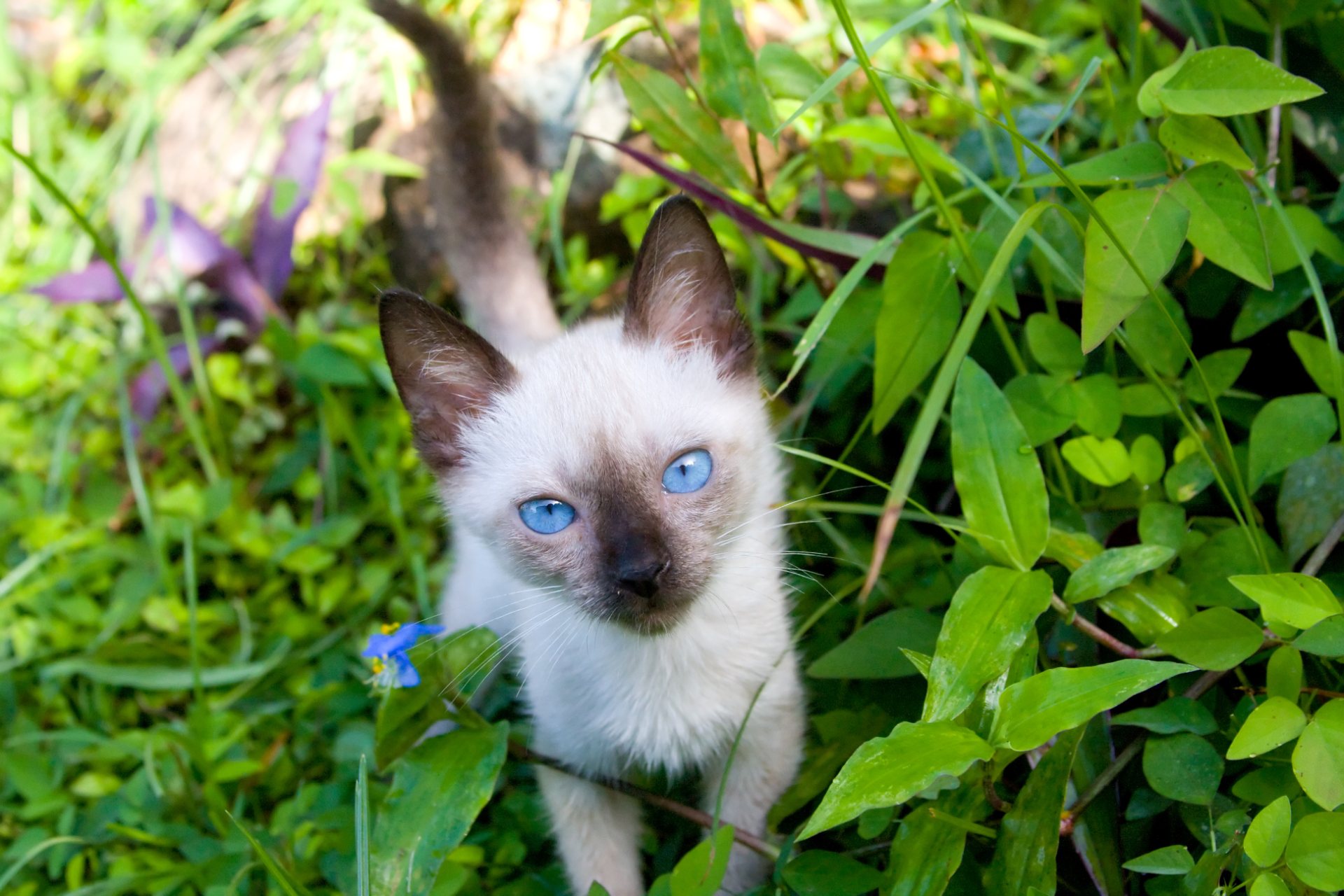These blue-eyed beauties are thought to be one of the oldest oriental cat breeds, originating in Thailand, formerly called Siam. Historically these cats were so highly prized that no-one except the king and royal family were allowed to own one.
They arrived in UK in the middle of the 19th century, exhibited in the first modern cat show in London where they were called ‘an un-natural, nightmare kind of cat’. How wrong they were! Nothing could be further from the truth.
This beautiful, svelte, intelligent cat with a big personality, coloured points (ears, nose, paws and tail) is friendly, lively and talkative and loves being the centre of attention!
There are three types of Siamese cat: the Applehead Siamese (traditional Siamese) with a round head, neat face, slanted eyes and a rounder body; the Classic Siamese that has a slightly wedge shaped face and head with a longer, more defined muzzle, longer legs and a slimmer more muscular body; and the Modern Siamese that has a defined wedge shaped face with a flat skull, large ears, a pronounced muzzle and a very slim frame.
The Modern Siamese cat is the one recognised and defined by the Governing Council of the Cat Fancy.
Pet profile
A talkative, intelligent, people-loving cat breed that’s bright, entertaining and great company!
- Size: 30 – 38 cm tall (12-15 inches at the shoulder)
- Weight: 4 – 6 KG (9 -15 Ibs in the biggest male cats)
- Life expectancy: 15 - 20 years
Exercise and nutrition
This clever, active breed loves attention and being part of everything you do. They can be trained to play fetch and walk on a lead, and will be getting into cupboards and finding new games to play to amuse himself when you’re not around. If you work long hours consider getting 2 cats as they love company and will play with each other while you’re not home. They need lots of toys to stimulate them mentally and keep them amused.
They need a high protein, high quality cat food with few carbohydrates, fed according to their weight. Ask your vet for feeding advice and take them to see your vet regularly for an overall check up to help keep them healthy.
Common health problems and illnesses
It’s always a good idea to buy a pure breed cat from a reputable breeder. The breed does have characteristic health issues to watch out for so ask to see your breeders genetic screening of their breeding animals for conditions such as Progressive Retinal Atrophy.
To ensure they have the best cat health care to take care of any issues that crop up, take out cat insurance while your kitten is young, before they develop any problems.
Like most cats, Siamese cats can suffer tartare build up and gum disease at any time. This condition, if left untreated, can develop into periodontal disease which is painful, can cause your cat to lose teeth and there is the potential for bacteria from infected gums to threaten your cat’s overall health. Modern and Classic Siamese with their longer, thin muzzles can suffer more frequently than other breeds and Petplan report mouth problems are the second most common illness they see in the breed. Feeding your Siamese a dry food to help keep their teeth clean and ensuring they get regular check ups at the vet can guard against this debilitating condition.
According to Petplan, Siamese cats are most likely to need treatment for gastrointestinal issues. Conditions such as blockages caused by your cat eating string or other toy parts can need surgery to sort out. Gastroenteritis cause by infections are pretty common and your vet can advise how to manage them. Intestinal tumours are prevalent in some breeding lines. If you think your cat might be suffering from a tummy problem take them to your vet for a check-up.
It is thought that up to a third of all Siamese cat carry a gene associated with Progressive Retinal Atrophy. You cat will only have the possibility of developing the condition if they have inherited this recessive gene from both parents. The condition causes a deterioration in the retina resulting in blindness eventually. There is no treatment for this condition, underlining the need to buy your cat from a reputable breeder. If you think your cat might have this condition consult your vet for tests and advice.
Bladder and kidney stones are seen more often in Siamese, Persian and domestic long-hair and British shorthair cats. They may not exhibit any symptoms but some may have difficulty urinating or have blood in their urine. Quite often they are diagnosed when checking for other health issues with an x ray or ultrasound. Causes can be not drinking enough, food that create alkaline urine, increased levels of calcium in the urine and blood or recurrent urinary tract infections. If you think your cat might have stones or problems urinating take them to your vet for tests, diagnosis and a treatment plan.
Fun facts
- Siamese cats come in 32 colour and pattern combinations but the most common have coloured points (ears, nose, paws and tail) in one of four colours; Seal points which are dark brown with pale ivory fur that may darken as the cat gets older, Chocolate points which are lighter brown with ivory white fur, Blue points which are a slate grey colour and Liliac points which are pale grey in colour.
- The singing, menacing Siamese cats in The Lady and the Tramp were called Si and Am (now I have the song as an ear worm! Look it up if you dare.. “We are Siamese if you please…we are Siamese if you don’t please…We are former residents of Siam.. there are no finer cat than I am!”)
- Liz Taylor loved her Siamese cat so much (they had the same coloured eyes) she gave James Dean a Siamese kitten called Marcus after meeting him filming ‘Giant’.

